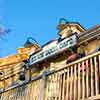Golden Horseshoe Revue and Saloon
BACKSTORY (July 17, 1955–Present): A special performance for Walt’s 30th Anniversary occurred July 13th. Saloon interior designed by Harper Goff (already working on designing Main Street when asked to work on GH). First show was Slue Foot Sue’s Golden Horseshoe Revue, a 45 min. show which ran 50,000+ times and is listed in the Guinness Book of Records as the longest-running musical of all time. In the early 1950’s, while appearing in revues in Australia, Wally Boag met tenor Donald Novis, who got Walt Disney to audition Wally for the Golden Horseshoe Revue, written by its first pianist Charles LaVere and lyricist Tom Adair. Novis was the show's first tenor (later replaced by Fulton Burley when he retired in 1962). Boag’s Pecos Bill/Traveling Salesman character specialized in slapstick humor, squirt guns, an endless supply of broken teeth (which he’d spit out), and his signature balloon animals (Boagaloons). Boag began his stint at the Horseshoe with a 2-week contract signed with Walt Disney. One of the features of the show was to have children in the audience sing & dance on stage; “Davy Crockett” was a favorite. The role of Slue Foot Sue originated with Judy Marsh, and then by Betty Taylor in 1956 (giving over 45,000 performances). Betty retired from the Revue in 1987. The Revue closed October 12, 1986 and was replaced by the Golden Horseshoe Variety Show, a similar production that closed in 1994. Outside on the front balcony, there is a periodic, comedic wild west shoot-em' up show.
 An episode of “The Wonderful World of Color,” celebrating the 10,000th performance of the Golden Horseshoe Revue aired on September 23, 1962. In 1963, Julie Andrews performed with Boag on the Golden Horseshoe stage along with the Dapper Dans, at a special media event promoting “Mary Poppins.” Andrews and Boag sang "By the Light of the Silvery Moon." Boag also voiced José for the Enchanted Tiki Room and wrote much of the script for the attraction as well as participating in the development of “The Haunted Mansion.” 1971 took Boag to Orlando, where he opened the Diamond Horseshoe Revue at Walt Disney World. In 1974, Boag returned to Disneyland, where the original act was featured in a 1980 Danny Kaye television special celebrating the park's 25th Anniversary. Wally retired in 1982, after having performed approximately 40,000 productions of the Revue. The Golden Horseshoe Revue closed in 1986 and was replaced by The Golden Horseshoe Jamboree. The Jamboree show was conceived and directed by Marilyn Magness.
An episode of “The Wonderful World of Color,” celebrating the 10,000th performance of the Golden Horseshoe Revue aired on September 23, 1962. In 1963, Julie Andrews performed with Boag on the Golden Horseshoe stage along with the Dapper Dans, at a special media event promoting “Mary Poppins.” Andrews and Boag sang "By the Light of the Silvery Moon." Boag also voiced José for the Enchanted Tiki Room and wrote much of the script for the attraction as well as participating in the development of “The Haunted Mansion.” 1971 took Boag to Orlando, where he opened the Diamond Horseshoe Revue at Walt Disney World. In 1974, Boag returned to Disneyland, where the original act was featured in a 1980 Danny Kaye television special celebrating the park's 25th Anniversary. Wally retired in 1982, after having performed approximately 40,000 productions of the Revue. The Golden Horseshoe Revue closed in 1986 and was replaced by The Golden Horseshoe Jamboree. The Jamboree show was conceived and directed by Marilyn Magness.
In 1995, Wally was inducted into the ranks of the Disney Legends and has his own window on Main Street above the Carnation Company. The inscription reads “Golden Vaudeville Routines - Wally Boag - Prop.” Currently, The Golden Horse Shoe saloon features Billy Hill & The Hillbillies.
Special thanks to Gene Sands for his assistance in verifying information for this page.
Sadly, Wally Boag and Betty Taylor recently passed away within hours of each other. Please visit my blog for a tribute post to both of them.
FROM THE DISNEYLANDER, JANUARY 1957
OLD WEST LIVES AGAIN
No Frontier musical revue worth the quality of its dancing girls was complete without musical accompaniment of a high caliber, a nd Disneyland's Golden Horseshoe "Saloon" - complete in every detail - has a trio of accompolished performers whose musical renditions add considerably to the show's old west flavor.
Holding down the vital role of leader of the Golden Horseshoe Orchestra is Professor Charley La Vere, a veteran performer at the keyboard who has sampled many mediums for hte display of his talents, but who seems to have found a natrual in the Golden Horseshoe orchestra pit.
Assisting him are Mel Patterson on drums and Frank Wylie on trumpet.
The Professor has been on hand to give the downbeat signaling the opening of the show since the Horseshoe's first performance. Expert musical accomplishment is the Professor's forte: In his more than 20 years in show business Charley has held down piano berths with Paul Whiteman, Skinnay Ennis, John Scott Trotter and Gordon Jenkins, as well as performing with notable success as a "single."
But the title of Professor is purely honorary, he avers. In the old days all piano players in saloons were called "Professor."
Charley started playing at nine in his home town of Salina, Kansas. He got the benefit of a teacher he might not have had except for Salina's healthy climate: a teacher from Boston Conservatory of Music, exiled to Kansas for his health, taught the lad for seven years.
Later, when Charley got to the University of Oklahoma at Norman, he did the natural thing and joined the campus band, and put his talent to work to help pay for his tuition expenses by playing at Saturday night dances.
The summer following his Sophomore year he journeyed to New York, arrived to find the era of the "Big Band" in full swing, caught on quickly in the big town andn "just never went back to Norman."
A lot was happening in those days in New York, Charley recalls, and he was sure he wanted to be a part of it. As a member of Paul Whiteman's Band he was right at the top of the popular music heap.
When Whiteman brought his group west to California on a personal appearance tour however, Charley was so taken with Califonria and the Los Angeles area that he never went back.
The big thing at this time was Network radio and he was more than equal to the challenge; his first engagement was with Skinnay Ennis on the "Bob Hope Show" and then later with Bing Crosby's program in the John Scott Trotter Orchestra.
The Professor counts among his notable singing accomplishments his Decca recording of "Maybe You'll Be There," a disk which sold over two million copies.
As the "Professor" of Disneyland's unique Golden Horseshoe "Saloon" (where nothing stronger than Pepsi Cola is ever served) Charley fills a historically vintal role as well as a functional one as the accompianist for the show's stars, Comedian Wally Boag and Silver Toned Tenor, Don Novis.
RUSS “LUCKY” REYNOLDS REMEMBERS…
 I have nothing but the fondest memories of working at the Horseshoe (1969 to 1974). Disneyland has been a family affair. My wife (high school sweetheart during the Horseshoe years) was Snow White in those days. I used to take off my bow-tie and garters to sneak off to Main Street and watch Cathy in the parade. Years later, our older daughter Kariann worked in Frontierland operations for five years. More recently, our youngest Katie danced in the Parade of Dreams and the Christmas Parade. Now she is a Laker Girl.
I have nothing but the fondest memories of working at the Horseshoe (1969 to 1974). Disneyland has been a family affair. My wife (high school sweetheart during the Horseshoe years) was Snow White in those days. I used to take off my bow-tie and garters to sneak off to Main Street and watch Cathy in the parade. Years later, our older daughter Kariann worked in Frontierland operations for five years. More recently, our youngest Katie danced in the Parade of Dreams and the Christmas Parade. Now she is a Laker Girl.
Back to the ‘Shoe. Wally, Betty and Fulton were still doing the Revue, with Bert as Wally’s sub. Several of the guys I worked with had a crush on one of the dancers (Terry Robinson) – she was a very nice gal. I never got tired of watching that show. At night the entertainment was highlighted by Sonny Hellmer and Banu Gibson doing a Roaring 20’s show. Sonny would chug an entire pitcher of Pepsi every show. Special engagements were common back then. Such stars as Conway Twitty, Xavier Cugat & Charro, Buddy Rich, etc. The Kids of the Kingdom weren’t bad either. Truly, working at the Horseshoe was always fun. I never had a hard time doing my shift. As to the inner workings of the operation, the work was hard because we had to fill the house and serve every guest before the show began. The menu included tuna, beef & cheese and ham & cheese sandwiches (the h & c had great marbled rye bread). The waitresses had the toughest duty by far. There were a lot of breaks, however. While the shoe was on we all retired to the little foreman’s office upstairs. We played a lot of pinochle and poker and quickly bonded into a very close group by virtue of the close quarters and the many breaks during a shift. Yes, there were several weddings between bartenders and waitresses over the years. Now, 40 odd years later, we go back often as season tickets holders. Although we Enjoy Billy Hill & the Hillbillys, they are a far cry from the Revue. Those were the days!
Pepsi was a huge sponsor of The Horsehoe for years, underwriting the expense of the excellent entertainment, etc. at this unique venue. Several years after I left in the 70’s they pulled-out and left the budget in a hole, which was too bad. Walt was right with his belief that the bottom line took care of itself if the vision remained pure.
Thanks for the opportunity for nostalgic memories.
Russ (Lucky) Reynolds
LANNIE REMEMBERS THE GOLDEN HORSESHOE…
 Some of my favorite Disneyland Golden Horseshoe memories are from when I was about 6 or 7 years old. My Dad worked for Pepsi-Cola from the 1950’s to the 1970’s. Every time we went to Disneyland (which was always once a year), my Dad made reservations for the Golden Horseshoe Revue at his Pepsi office, then we would check in at the GHR podium once we got to the park. The table would be on the left hand stage balcony and there would be a sign there that read “Reserved for Pepsi.” I remember the big Pepsi name on the curtains and I really thought my Dad was the most important man there.
Some of my favorite Disneyland Golden Horseshoe memories are from when I was about 6 or 7 years old. My Dad worked for Pepsi-Cola from the 1950’s to the 1970’s. Every time we went to Disneyland (which was always once a year), my Dad made reservations for the Golden Horseshoe Revue at his Pepsi office, then we would check in at the GHR podium once we got to the park. The table would be on the left hand stage balcony and there would be a sign there that read “Reserved for Pepsi.” I remember the big Pepsi name on the curtains and I really thought my Dad was the most important man there.
Being that we were on the stage we received a lot of eye-contact from Fulton and Betty and Wally. Of course, then I KNEW my Dad was the most important man there! Anyway, I'll never forget Wally coming on stage. He was magic for me. I couldn't believe how many teeth he had to spit out of his mouth! My parents laughed out loud and Dad told me “Yes, of course those are his real teeth!” I also thought Wally was pretty slick with those squirt guns. Times like those were especially wonderful; our whole family being together, laughing and enjoying a bag of Fritos and an ice cold Pepsi! Of course my sister later marries a guy who works at Coke!
At left: Lannie with GH legend Wally Boag
THE PAINTING ABOVE THE BAR
 I've always wondered about the origins of this interesting painting that hangs behind the bar in the Golden Horseshoe Saloon. Two readers have chime in with information about it; first up is BM
I've always wondered about the origins of this interesting painting that hangs behind the bar in the Golden Horseshoe Saloon. Two readers have chime in with information about it; first up is BM
"It's from the 1963 Disney film 'Summer Magic.' There's a scene where Burl Ives' character is looking at portraits and the first one shows the one in the Golden Horseshoe. The only visible difference I can see is in the way part of the curtain drapes in the middle.
This tidbit came from Mike Cozart of TomorrowLounge 67:
The saloon vixen painting hanging in the Golden Horseshoe was first used by Disney in the film Summer Magic --it was one of the many paintings stored away in Burl Ives store -- and one of the many painting contemplated to represent the owner of the Big Yellow house by Haley Mills!
THE BLACK DAHLIA, JANICE KNOWLTON, AND THE GOLDEN HORSESHOE
 Barry, whose touching Grad Night story is over on the Frontierland page also had this to share:
Barry, whose touching Grad Night story is over on the Frontierland page also had this to share:
I have also always wondered about one of the can can dancers at the Golden Horseshoe. Her name was Janice Knowlton and she was convinced her dad was the Black Dahlia murderer. She committed suicide in 2004 and I had met her at one of the restaurants where she sang way back in the 70’s when she was singing at either Mario’s or the Five Crowns Restaurant. I can’t recall which one. She was a nice smallish woman who was talking to a few people between sets and mentioned she was from Beverly, MA; my aunt was from there as well and that got my aunt and Janice talking. Then my wife at the time also started talking with Janice and we found out that she was formerly a can-can dancer at the Golden Horseshoe and a secretary at Disneyland. She never mentioned her dad then. I was a student at OCC back then and I had on a t-shirt from there and she mentioned she had attended a short time when she was younger. Since I collect yearbooks from the Newport –Costa Mesa area and OCC as well, I looked her up in the 1955 OCC yearbook and she is in there! I do recall seeing a color photo somewhere of her can-can group. She was a dancer from 1970-1973 or about then. Many years later I was reading the various books on the Black Dahlia and then I noticed the name of the author of “Daddy Was the Black Dahlia Killer.” I wondered if it was the same person and I found that it was! I didn’t buy the premise of her story but she obviously had a very troubled life. To have been as talented as she was is just amazing considering what she believed about her family. I am not sure what else to say here. I only met Janice that one night and she was a really nice woman who treated our whole table with such warmth and kindness. I have since shared a couple emails with her sister Beverly Fournier online but only about her music and that fact that she lived in Anaheim up until her death. It wasn’t all that far from where I lived. I think I’ll let her know I found at least one photo of her sister in the OCC yearbook. I still feel so badly for her after all this time. What a life! Her sister has this memorial site I just found tonight: janice-knowlton.memory-of.com
The information on her sister’s website includes this:
She moved back to Orange County, California in August 1969 and stayed there until October when she moved to San Francisco. In San Francisco she met and married Bart Sandberg and they lived there and then in Portland, Oregon. The marriage broke up in April 1973 and she moved back to Orange County finding work as a secretary at Disneyland in late July 1973.
She appeared with the Disneyland Players in their production of The Sound of Music as the mother superior. Each time she hit a high C she received a standing ovation from each and every audience member who attended each of the productions.
She danced in The Horseshoe Review for several seasons. Janice also appeared in The Long Beach Civic Light Opera and at The Forum Theater at California State University in Fullerton where she entertained many times. She appeared on stage there with Comic George Gobel in 1985.
 An episode of “The Wonderful World of Color,” celebrating the 10,000th performance of the Golden Horseshoe Revue aired on September 23, 1962. In 1963, Julie Andrews performed with Boag on the Golden Horseshoe stage along with the Dapper Dans, at a special media event promoting “Mary Poppins.” Andrews and Boag sang "By the Light of the Silvery Moon." Boag also voiced José for the Enchanted Tiki Room and wrote much of the script for the attraction as well as participating in the development of “The Haunted Mansion.” 1971 took Boag to Orlando, where he opened the Diamond Horseshoe Revue at Walt Disney World. In 1974, Boag returned to Disneyland, where the original act was featured in a 1980 Danny Kaye television special celebrating the park's 25th Anniversary. Wally retired in 1982, after having performed approximately 40,000 productions of the Revue. The Golden Horseshoe Revue closed in 1986 and was replaced by The Golden Horseshoe Jamboree. The Jamboree show was conceived and directed by Marilyn Magness.
An episode of “The Wonderful World of Color,” celebrating the 10,000th performance of the Golden Horseshoe Revue aired on September 23, 1962. In 1963, Julie Andrews performed with Boag on the Golden Horseshoe stage along with the Dapper Dans, at a special media event promoting “Mary Poppins.” Andrews and Boag sang "By the Light of the Silvery Moon." Boag also voiced José for the Enchanted Tiki Room and wrote much of the script for the attraction as well as participating in the development of “The Haunted Mansion.” 1971 took Boag to Orlando, where he opened the Diamond Horseshoe Revue at Walt Disney World. In 1974, Boag returned to Disneyland, where the original act was featured in a 1980 Danny Kaye television special celebrating the park's 25th Anniversary. Wally retired in 1982, after having performed approximately 40,000 productions of the Revue. The Golden Horseshoe Revue closed in 1986 and was replaced by The Golden Horseshoe Jamboree. The Jamboree show was conceived and directed by Marilyn Magness.
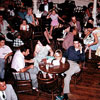
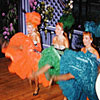
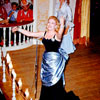
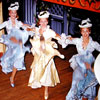
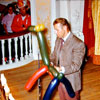
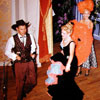
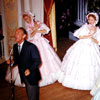






















































































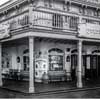

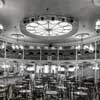
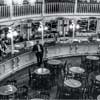

















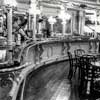







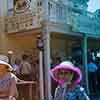



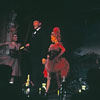









































 Some of my favorite Disneyland Golden Horseshoe memories are from when I was about 6 or 7 years old. My Dad worked for Pepsi-Cola from the 1950’s to the 1970’s. Every time we went to Disneyland (which was always once a year), my Dad made reservations for the Golden Horseshoe Revue at his Pepsi office, then we would check in at the GHR podium once we got to the park. The table would be on the left hand stage balcony and there would be a sign there that read “Reserved for Pepsi.” I remember the big Pepsi name on the curtains and I really thought my Dad was the most important man there.
Some of my favorite Disneyland Golden Horseshoe memories are from when I was about 6 or 7 years old. My Dad worked for Pepsi-Cola from the 1950’s to the 1970’s. Every time we went to Disneyland (which was always once a year), my Dad made reservations for the Golden Horseshoe Revue at his Pepsi office, then we would check in at the GHR podium once we got to the park. The table would be on the left hand stage balcony and there would be a sign there that read “Reserved for Pepsi.” I remember the big Pepsi name on the curtains and I really thought my Dad was the most important man there.  I've always wondered about the origins of this interesting painting that hangs behind the bar in the Golden Horseshoe Saloon. Two readers have chime in with information about it; first up is
I've always wondered about the origins of this interesting painting that hangs behind the bar in the Golden Horseshoe Saloon. Two readers have chime in with information about it; first up is  Barry, whose touching Grad Night story is over on the
Barry, whose touching Grad Night story is over on the
































































































